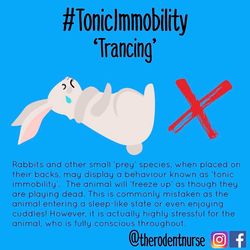Trancing
Trancing rabbits is the action of placing rabbits on their back to induce a paralysis known as tonic immobility, death-feigning, apparent death, or dorsal recumbancy. The action is also known as the immobility response, hypnosis, or the freeze response.[1]:61
Signs of a tranced rabbit
Your rabbit will display the following behaviors if it is tranced:
- Closed eyes
- Shallow fast breathing
- Relaxed limbs
Rabbits can be tranced if they are physically restrained on their backs and their head is level or below their backs.[2] As long as the head is flexed with the chin against the neck, the rabbit remains immobile.[1]:61
Controversy
Contrary to popular belief, rabbits in a state of tonic immobility are not relaxed, hypnotized, or insensitive to pain.[3] Scientists believe that this is a defense mechanism brought on when a rabbit has already been 'caught' by a predator. If the rabbit appears dead, the predator may release its grip momentarily and allows the rabbit to escape. Research has shown that rabbits in this state show an increased heart and respiratory rate with elevated plasma corticosterone levels, indicative of fear-induced stress.[4]
The stress caused by this position can be fatal if rabbits are already suffering from respiratory and cardiovascular disease, and the sudden transition to from passive and active escape can be unpredictable and instantaneous which can result in significant injury to the rabbit.[3] Sudden noise or painful stimuli can interrupt the trance and there is considerable variation in individual susceptibility to the technique.[1]:61 One example story from a rabbit rescue of a rabbit that died from being handled in a trance for an extended period of time while groomed.
As a result, it is inappropriate to advocate the use of the immobility response in order to promote bonding between a rabbit and an owner, but it is justifiable in veterinary practices in order to avoid unnecessary anaesthesia.[1]:61
Proven cardiac changes during death-feigning (tonic immobility) in rabbits (Oryctolagus cuniculus)
- Amália Turner Giannico, Leandro Lima, Rogério Ribas Lange, Tilde Rodrigues Froes, Fabiano Montiani-Ferreira
Tonic immobility (TI) is a response to fear or threat by remaining motionless, principally when attacked by predators from which there is no possibility of escape. Thus, here we demonstrate a way of easily reproducing this phenomenon in a laboratory setting and characterize the cardiac electromechanical alterations during TI. We observed a significant decrease in heart rate (HR) and changes of rhythm in electrocardiogram during TI in rabbits. Echocardiogram showed a significant increase in the left ventricle chamber diameter during systole and a consequent decrease in fractional shortening and ejection fraction, in addition to the HR and rhythm changes. There was also a significant decrease in aortic and pulmonary artery blood flow. Diastolic functional changes included a significant decrease of the peak atrial contraction velocity (A peak) and consequent increase in the ratio of peak early diastolic velocity to A peak and increased isovolumetric relaxation time. We were able to prove that TI changes the cardiac function considerably. Although the "fight-or-flight" response is the most common response to fear, which is characterized by the action of sympathetic nervous system with tachycardia and increased physical activity, TI is an alternative anti-predator behavior causing cardiac changes opposite to the "fight-or-flight" phenomenon.
- Journal of Comparative Physiology A Neuroethology, Sensory, Neural, and Behavioral Physiology, 2014 Apr;200(4):305-10. PMID: 24515628 DOI: 10.1007/s00359-014-0884-4,
Further reading
- Rabbit Welfare Association & Fund. Trancing
- Anne McBride. (2015). Animals in trances: peace of mind or panic? [PDF]
- Amália Turner Giannico et al. (2014). Proven cardiac changes during death-feigning (tonic immobility) in rabbits (Oryctolagus cuniculus)
- Anne McBride et al. (2006). Trancing rabbits: Relaxed hypnosis or a state of fear?
- Abstract hosted @ the University of Huddersfield. (2006). Trancing Rabbits: Relaxed hypnosis or a state of fear?
- Gallup, G.G. (1974). Animal hypnosis: factual status of a fictional concept.
- bunnyhugga. (2010). Tonic immobility (trancing / hypnotising rabbits)
- Giancarlo Carli. (1977). Animal Hypnosis in the Rabbit
- Stanley C. Ratner. (1958). Hypnotic Reactions of Rabbits
- Wikipedia. Apparent Death
Below are some relevant discussions about rabbit trancing.
- Bunny Lovers Unite. (2006). Bunny Trance!
- r/rabbits. (2012). My rabbit likes to be cuddled upside down
- Rabbits Online. (2013). The dangers of "trancing" Please read.
See also
References
- ↑ 1.0 1.1 1.2 1.3 Varga, M. (2013). Textbook of rabbit medicine. (2nd ed.).
- ↑ Fraser, M. A., & Girling, S. (2009). Rabbit medicine and surgery for veterinary nurses. Retrieved from http://books.google.com/books?id=Nn-3h3kMFUUC&pg=PA80&dq=rabbit+trancing&hl=en&sa=X&ei=gvPHUsOvNsvMsQTd7YGgDg&ved=0CDgQ6AEwAg#v=onepage&q=rabbit%20trancing&f=false
- ↑ 3.0 3.1 Cooper, B., Turner, L., & Mullineaux, E. (2011). Animal handling, restraint, and transport. In The BSAVA textbook of veterinary nursing. (5th ed.). Retrieved from http://www.bsava.com/Portals/4/knowledgevault/publications/files/Textbook_Veterinary_Nursing_5e.pdf
- ↑ Proceedings of the VDWE International Congress on Companion Animal Behaviour and Welfare, E.A. McBride et al., Trancing rabbits: Relaxed hypnosis or a state of fear?



